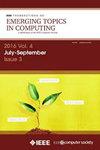Towards Label-Efficient Deep Learning-Based Aging-Related Bug Prediction With Spiking Convolutional Neural Networks
IF 5.4
2区 计算机科学
Q1 COMPUTER SCIENCE, INFORMATION SYSTEMS
IEEE Transactions on Emerging Topics in Computing
Pub Date : 2025-01-24
DOI:10.1109/TETC.2025.3531051
引用次数: 0
Abstract
Recent advances in Deep Learning (DL) have enhanced Aging-Related Bug (ARB) prediction for mitigating software aging. However, DL-based ARB prediction models face a dual challenge: overcoming overfitting to enhance generalization and managing the high labeling costs associated with extensive data requirements. To address the first issue, we utilize the sparse and binary nature of spiking communication in Spiking Neural Networks (SNNs), which inherently provides brain-inspired regularization to effectively alleviate overfitting. Therefore, we propose a Spiking Convolutional Neural Network (SCNN)-based ARB prediction model along with a training framework that handles the model’s spatial-temporal dynamics and non-differentiable nature. To reduce labeling costs, we introduce a Bio-inspired and Diversity-aware Active Learning framework (BiDAL), which prioritizes highly informative and diverse samples, enabling more efficient usage of the limited labeling budget. This framework incorporates bio-inspired uncertainty to enhance informativeness measurement along with using a diversity-aware selection strategy based on clustering to prevent redundant labeling. Experiments on three ARB datasets show that ARB-SCNN effectively reduces overfitting, improving generalization performance by 6.65% over other DL-based classifiers. Additionally, BiDAL boosts label efficiency for ARB-SCNN training, outperforming four state-of-the-art active learning methods by 4.77% within limited labeling budgets.基于标记高效深度学习的脉冲卷积神经网络老化相关Bug预测
深度学习(DL)的最新进展增强了老化相关错误(ARB)预测,以减轻软件老化。然而,基于dl的ARB预测模型面临双重挑战:克服过度拟合以增强泛化,并管理与大量数据需求相关的高标记成本。为了解决第一个问题,我们利用了尖峰神经网络(snn)中尖峰通信的稀疏性和二值性,它固有地提供了大脑启发的正则化来有效地缓解过拟合。因此,我们提出了一个基于尖峰卷积神经网络(SCNN)的ARB预测模型,以及一个处理模型时空动态和不可微性质的训练框架。为了降低标签成本,我们引入了生物启发和多样性意识主动学习框架(BiDAL),该框架优先考虑高信息量和多样性的样本,从而更有效地利用有限的标签预算。该框架结合了生物启发的不确定性来增强信息性测量,并使用基于聚类的多样性感知选择策略来防止冗余标记。在三个ARB数据集上的实验表明,ARB- scnn有效地减少了过拟合,与其他基于dl的分类器相比,其泛化性能提高了6.65%。此外,BiDAL提高了ARB-SCNN训练的标签效率,在有限的标签预算下,比四种最先进的主动学习方法高出4.77%。
本文章由计算机程序翻译,如有差异,请以英文原文为准。
求助全文
约1分钟内获得全文
求助全文
来源期刊

IEEE Transactions on Emerging Topics in Computing
Computer Science-Computer Science (miscellaneous)
CiteScore
12.10
自引率
5.10%
发文量
113
期刊介绍:
IEEE Transactions on Emerging Topics in Computing publishes papers on emerging aspects of computer science, computing technology, and computing applications not currently covered by other IEEE Computer Society Transactions. Some examples of emerging topics in computing include: IT for Green, Synthetic and organic computing structures and systems, Advanced analytics, Social/occupational computing, Location-based/client computer systems, Morphic computer design, Electronic game systems, & Health-care IT.
 求助内容:
求助内容: 应助结果提醒方式:
应助结果提醒方式:


